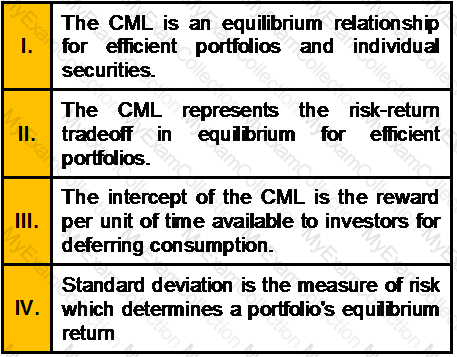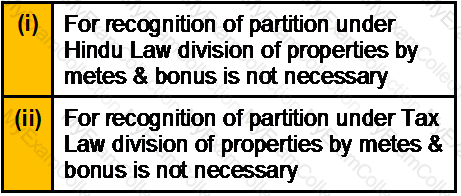Section B (2 Mark)
If a portfolio manager has a good ability to select undervalued securities but a poor ability to forecast overall market, the following makes sense for him:
Section A (1 Mark)
What would be the tax liability if tea and snacks are provided in the office after office hours?
Section B (2 Mark)
On 1st February 2009, Mr. Dutt took a personal loan of Rs. 1,00,000 for a period of 3 years at an 21% rate of interest .The loan is to be on monthly EMI on monthly reducing balance method.
What would be interest and principal amount to be paid in November 2011?
Section A (1 Mark)
___________is concerned with the rational solution to the problem at hand. It defines an idea that actual decisions should strive to approximate.
Section A (1 Mark)
An activity is presumed to be a profit-making activity rather than a hobby if the
Section B (2 Mark)
Suppose you have some money to invest and you hear about a great stock tip from your neighbor who is known to have a good stock market sense. He recommends you purchase shares in Petrolite, a company that makes a new kind of lighter fluid for charcoal grills.
What is your response to this situation if you exhibit Availability bias?
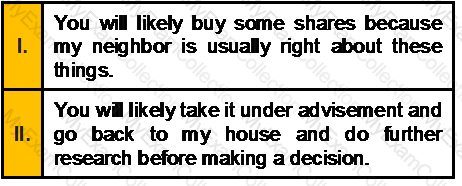
Section B (2 Mark)
Mr. A purchased certain shares of a company during the financial year 1987-88 for a sum of Rs.1,50,000/-. A sold the shares during the financial year 2011-12 for Rs.8,10,000/- when the market is at all time high. Calculate the amount of capital gains. [CII-12-13: 852,11-12: 785,10-11:711]
Section B (2 Mark)
Which of the following statements is/are correct with respect to Resident Very Senior Citizen i.e. who is of an age of 80 years and above?
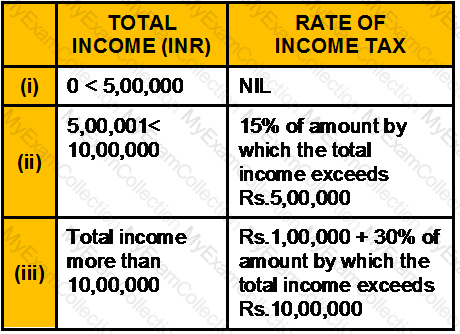
Section C (4 Mark)
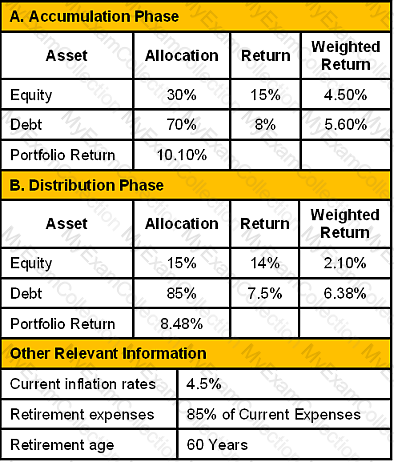
Mr. Raman Gehlot, aged 55 years, is owner of midsized business firm. His family consists of his wife Anupama, aged 55, son Nishant aged 29 and daughter Nivedita aged 27. His wife is a housewife and social worker. Both of their children are happily married and well settled. The couple anticipates their life expectancy to be 75 years each.
The gross annual income of Raman for the previous year 2010–11 is expected to be Rs. 9,60,000. The couples’ household expenses are estimated to be Rs. 4,90,000 p.a. Taking into account incidental expenses of another Rs. 85,000 the net expenses of the family are estimated to be Rs. 5,75,000 for the previous year 2010–11. Thus they achieved a net surplus of Rs. 3,85,000 during the year. Raman has a net saving of Rs. 12,00,000 which he would like to invest for his post retirement purposes at the beginning of the year.
Currently Raman has approximately 5 years left for retirement and thus he is not very aggressive in his investments. The returns of his portfolio based on asset allocation during the accumulation and distribution phase are calculated as below:
Section C (4 Mark)
Read the senario and answer to the question.
By calculating HLV of Mahesh indicate the shortfall in his life insurance coverage using the given data:
Mr. Mahesh age 52, retirement age 60, paying professional tax of Rs. 5800 and income tax subject to allowable deductions as Rs. 230000, reasonable self maintenance expenditure estimated Rs. 140000 p.a., life insurance premium for self Rs. 25000 with total sum assured Rs. 1200000. He also pays insurance premium of Rs. 15500 and Rs. 7000 for life insurance policy of his wife and son respectively. Rate of interest assured for capitalization of future income is at 7%
Section A (1 Mark)
An insured becomes entitled for getting No Claim Bonus only at the renewal of a policy after the expiry of the full duration of _________ months.
Section A (1 Mark)
Which of the following is not true about traditional defined benefit plans?
Section B (2 Mark)
What is the PV of an Annuity Due which provides Rs. 2,000/- per month for first 3 years and then Rs. 3,000/- per month for next 2 years. This annuity starts 4 years from now and ROI is 9 % per annum compounded monthly?
Section C (4 Mark)
Allianz is a number one accredited institute for the Engineering in New Delhi. It pays dividend per share of Rs. 0.24 on reported earning per share of Rs. 0.512 in 2007. The firms earnings per share have grown at 8% over the prior 5 year but that growth rate is expected to decline linearly over the next 5 years to 3%, while the payout ratio remains unchanged. The beta for the stock is 0.9. The risk free rate is 4.2% and the market risk premium is 4%.Calculate the price of the stock.
Section B (2 Mark)
An Indian citizen leaving India during the previous year for employment purpose is said to be resident If:
Section A (1 Mark)
The most profitable credit card customers for a bank are those that:
Section B (2 Mark)
Which of the following Biases are exhibited by Passive Preserver?
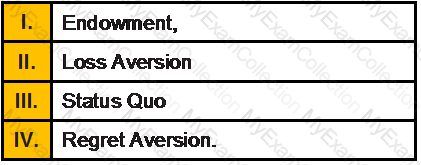
Section A (1 Mark)
Which of the following types of income is received by individuals without deduction of basic rate tax?
Section A (1 Mark)
When markets are in equilibrium, the CML will be upward sloping
Section A (1 Mark)
Psychologists have found that people who make decisions that turn out badly blame themselves more when that decision was unconventional. The name for this phenomenon is
Section A (1 Mark)
We prefer a sure gain from a much larger gain that is very likely but not certain. This makes us close winning positions even if we think that they are likely to get even better.
Section A (1 Mark)
In which year can the subscriber to a PPF account take the first loan from the opening of the account?
Section A (1 Mark)
A _________ portfolio is a well-diversified portfolio constructed to have a beta of 1 on one of the factors and a beta of 0 on any other factor.
Section A (1 Mark)
The difference between a wagering contract and insurance contract is ___________.
Section B (2 Mark)
Vikrant Juneja gifted his house property to his wife in year 2007. Mrs. Juneja then lets out this house @ Rs. 5000 per month. The income from such house property will be taxable in the hands of:
Section B (2 Mark)
____________compares the price charged for property or services transferred in a controlled transaction to the price charged for property or services transferred in a comparable uncontrolled transaction in comparable circumstances
Section C (4 Mark)
Suppose you have a two-security portfolio containing Bonds A and B. The market value of Bond A is Rs. 6,000, and the market value of Bond B is Rs4,000. The duration of Bond A is 8.5, and the duration of Bond B is 4.0. Calculate the duration of the portfolio.
Section B (2 Mark)
Property A provides an annual income of Rs. 160,000 and a similar property B has sold based on 8 % capitalization rates. Calculate the value at which property A can be priced.
Section A (1 Mark)
Investments that are difficult to convert to cash are said to have _________
Section A (1 Mark)
Deduction u/s 80U in case of permanent physical disability (including blindness) allowed to:
Section A (1 Mark)
…………………. Is implied in favor of the party creating it
Section B (2 Mark)
The minimum service required for entitlement to payment of gratuity under the Act, in case of an employee leaving service by death or incapacitation is
Section A (1 Mark)
You have added more money to a losing stock twice, despite no good news about the stock. You are likely demonstrating which type of judgment error?
Section A (1 Mark)
----------- shifts the weights of securities in the portfolio to take advantage of areas that are expected to do relatively better than other areas.
Section C (4 Mark)
Read the senario and answer to the question.
Vinay wants to have 80% of the desired retirement corpus from his monthly savings from now itself. If he expects to earn 12% p.a. on these savings, how much amount should the couple save at the end of each month to achieve this target?
Section A (1 Mark)
____________represents people’s propensity to claim an irrational degree of credit for their successes.
Section C (4 Mark)
You are given the following set of data:
Historical Rate of Return
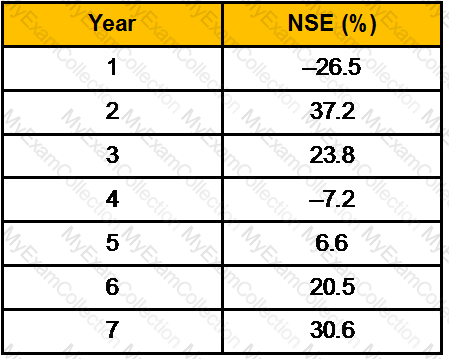
Determine the arithmetic average rates of return and standard deviation of returns of the NSE over the period given.
Section B (2 Mark)
A dealer sold one January Nifty futures contract for Rs.250,000 on 15th January. Each Nifty futures contract is for delivery of 50 Nifties. On 25th January, the index closed at 5100. How much profit/loss did he make ?
Section B (2 Mark)
Consider the single-factor APT. Stocks A and B have expected returns of 15% and 18%, respectively. The risk-free rate of return is 6%. Stock B has a beta of 1.0. If arbitrage opportunities are ruled out, stock A has a beta of __________.
Section A (1 Mark)
The Eligibility Criteria for Personal Loans for Self Employed Professionals & Businessman in India states that the minimum age of the applicant should be:
Section A (1 Mark)
The steps to establishing an investment policy are to state the
Section B (2 Mark)
An investor is bearish about Tata Motors and sells ten one-month ABC Ltd. Futures contracts at Rs.6,06,000. On the last Thursday of the month, Tata Motors closes at Rs.600. He makes a _________. (assume one lot = 100)
Section B (2 Mark)
Which of the following statements with respect to International Taxation Structure is/are correct?
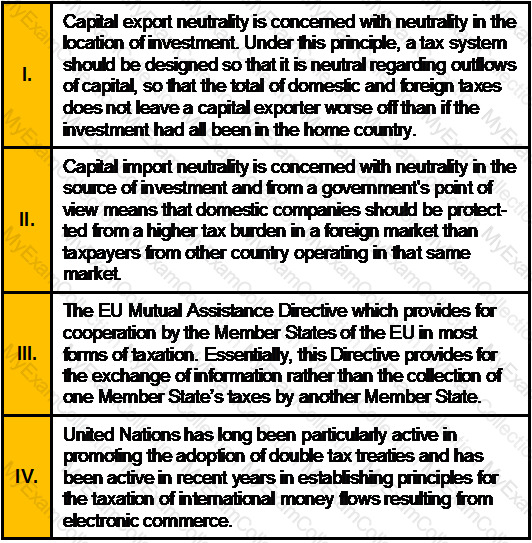
Section A (1 Mark)
Which of the following is not a Key Benefit of the In-kind process used by the ETFs?
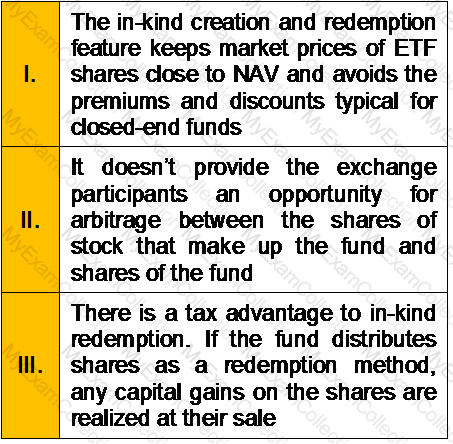
Section A (1 Mark)
The fact that a consumer feels a strong moral and ethical responsibility to repay a loan on time refers to the ______________________ of that individual.
Section A (1 Mark)
Deduction under section 80QQB is allowed to an author of a book of literary or artistic or scientific nature who is resident in India to the extent of:
Section A (1 Mark)
Select the CORRECT statement regarding basis risk associated with futures.
Section A (1 Mark)
You buy a investment plan by investing Rs. 6000/- per month for first 12years and Rs. 11000/- per month for next 12 years. If the rate of interest is 15% per annum compounded monthly . How much amount would you have after 24 years?
Section C (4 Mark)
Mr. Amit Jain has bought a house today which cost him Rs. 50 lacs by taking a loan of 30lacs for 15 years at 11% per annum compounded monthly. He currently has 10 lacs of financial assets and plans to save Rs. 3.25 lacs every year at the beginning of the year for the next 5 years. All his investments are expected to grow at a ROI of 15%per annum compounded quarterly. What will be the net worth of Mr. Amit after 5 years if the value of the house after 5 years is expected to be 75 lacs.
Section A (1 Mark)
An equity analyst working for a growth oriented mutual fund has a tendency to misvalue the stocks of popular companies that she has previously recommended and the fund already owns. Her behavior is most likely consistent with which of the following biases?
Section C (4 Mark)
Read the senario and answer to the question.
Harish wants a monthly investment to achieve the goal of his children's higher education. For accumulation of fund you recommend Harish to invest in an investment vehicle which invests in the ratio of 20:80 in Debt and Equity. If Harish starts investing from 1st Dec 2010, what approximate amount should he set aside every month for each child to achieve the goal? Harish maintains separate investment accounts for Chirag and Vishesh and invests till they individually turn 21 years of age.
Section B (2 Mark)
In case of a defined benefit plan where the benefit payable is based on the terminal salary, an increase in of 10% of the wages of the employees would increase the contribution to be made by the employer for the benefit by
Section B (2 Mark)
The equity risk premium for the market is 8 percent. Jackson Products has a beta of 0.4. The real risk-free rate is 2 percent and the expected inflation premium is 5 percent. The required rate of return for Jackson is __________ percent.
Section A (1 Mark)
According to Prospect Theory, investors are more concerned with changes in wealth than in returns. Prospect Theory suggests that investors:
Section A (1 Mark)
A draft of a will prepared by the head of the family which will decide the nature in which his properties will be distrubuted among his heirs is known as_____________________.
Section A (1 Mark)
Which of the following is an advantage of a credit scoring model?
Section A (1 Mark)
The way to reduce tax liability by taking full advantage provided by the Act is
Section A (1 Mark)
In reality, when risk and uncertainty or incomplete information about an alternative or high degree of complexity is introduced, people or organizations may be have somewhat different from rationality. This is called ___________.
Section C (4 Mark)
Nifty is at 3200. Mr. XYZ expects very little movement in Nifty. He sells 2 ATM Nifty Call Options with a strike price of Rs. 3200 at a premium of Rs. 97.90 each, buys 1 ITM Nifty Call Option with a strike price of Rs. 3100 at a premium of Rs. 141.55 and buys 1 OTM Nifty Call Option with a strike price of Rs. 3300 at a premium of Rs. 64.
What would be the Net Payoff of the Strategy?
• If Nifty closes at 3200
• If Nifty closes at 4212
Section C (4 Mark)
Mr. XYZ is bullish about ABC Ltd stock. He buys ABC Ltd. at current market price of Rs. 4000 on 4th July. To protect against fall in the price of ABC Ltd. (his risk), he buys an ABC Ltd. Put option with a strike price Rs. 3900 (OTM) at a premium of Rs. 143.80 expiring on 31st July.
What would be the Net Payoff of the Strategy?
• If ABC Ltd closes at 3458
• If ABC Ltd closes at 4352
Section A (1 Mark)
Under Nayak Committee Method the gross working capital is uniformly assumed to be a minimum of ________ of projected gross sales
Section C (4 Mark)
Amit an industrialist wants to buy a flat in a housing society presently costing Rs. 35,00,000/- after 6 years. The cost of the house is expected to increase by 15% p.a for the first 3 years and by 10% in the remaining years. Amit wants to start a SIP with monthly contributions in Birla Front Line Equity Mutual Fund to pay for the down payment of the house which would be 25% of the house value at that time. You as a CWM expect that the fund would give ROI of 14% p.a. compounded monthly in the next 10 years. Please advise Amit the monthly SIP amount starting at the beginning of every month for the next 6 years to fulfill his goal of buying the Flat he desires.
Section B (2 Mark)
From the following data calculate the covariance between stock A and stock B
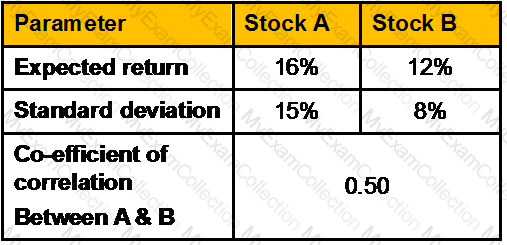
Section C (4 Mark)
Mr. Sushobhan Adhikari, 56 years old, employee of Mega India Ltd, receives the following salary and perquisites from his employer during the previous year 2007–08.
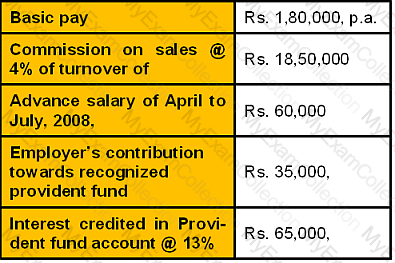
A rent-free furnished house in Patna (rent of unfurnished house paid by employer- Rs. 84,000, rent of furniture Rs. 18,000, free services of a gardener (salary-Rs. 4,000), free services of cook (salary-Rs. 3,600), free services of watchman (salary-Rs. 900). He owns a small house at Patna.
Mr. Adhikari makes the following payments and investments during the year:
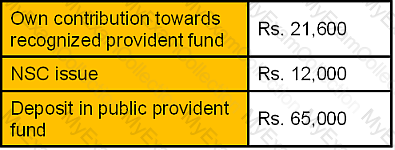
Mr. Adhikari comes to Mr. Gupta, CWM®, in September-2008 for developing a wealth plan to fulfill his financial goals. Mr. Adhikari will retire on 31st December, 2008 after completing 28 years of service. He is expecting a growth of Rs. 1,500 in his basic pay in the last year of his employment. The company is expecting a 5% growth every year in its turnover. His daughter Pallavi has completed her education and his main liability is the amount he may have to spend for her marriage. On his retirement he is expected to receive following amount:
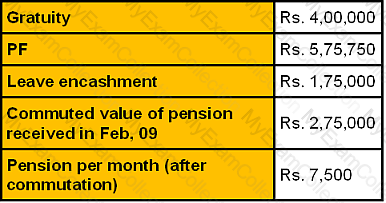
He also has also informed to the planner following his other assets and investments:
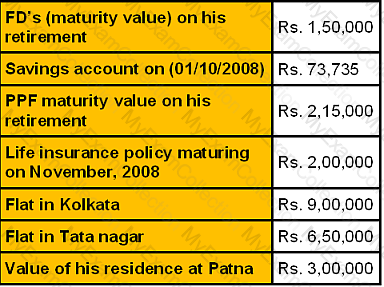
He has given his Kolkata Flat on 12,500 p.m. rent. Municipal value of the property is Rs. 1,45,000, fair rent is Rs. 1,60,000 and standard rent is 1,40,000. Municipal tax paid by him are as follows:

In July, 2008 rent is increased from Rs. 11,500 to Rs. 12,500 pm with effect from 01/04/2007. Due to some dispute rent was not received in 2007–08 but all arrears of rent till date are paid on July 1, 2008. Maximum eligible amount of PPF contribution deposited in March, 2008.
His actual expenses before retirement are Rs. 23,500 per month.
Main goals of Mr. Adhikari:
â—To provide for his daughter’s marriage
â—Ensuring that his family is protected financially in the event of any mishap
â—Minimize tax burden
â—Establish an investment portfolio that gives high returns over long term
Assumptions:
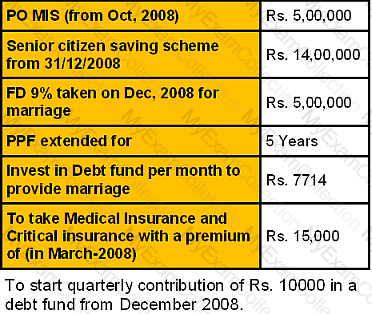
â—Mr. Adhikari needs to provide for himself and his family till he is 75.
â—Inflation rate after retirement to be 4%
â—Monthly expenses after retirement will be 15% less than before retirement
After detailed discussion, Mr. Gupta, CWM®, has suggested a revision in the portfolio as below to be implemented from October, 2008.
Section A (1 Mark)
Which ONE of the following in not the requirement for managing customer?
Section A (1 Mark)
Mr. Sharma invested Rs. 2,00,000 in an investment that gives Rs 40,000/- for the first 4 years, and Rs. 60,000/- for next 3 years. If the discount rate is 12 %, calculate the Present Value of these cash flows?
Section A (1 Mark)
Which of the following can be the underlying for a commodity derivative contract?
Section C (4 Mark)
Watts Industries, a manufacturer of valves for industrial and residential use, had the following projected free cash flows to equity per share for the next five years , in nominal terms.
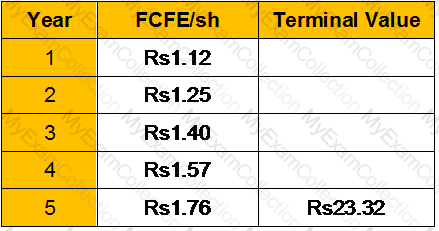
The terminal price is based upon a stable nominal growth rate of 6% a year after year 5. The discount rate, based upon financial market rates, is 14%, and the expected inflation rate is 3%.
Estimate the value per share, using nominal cash flows and the nominal discount rate.
Section C (4 Mark)
Read the senario and answer to the question.
Assume the following additional facts:
The Shankers have purchased a homeowner’s policy (comprehensive) covering 100% of the replacement cost of their residence. This policy has a Rs. 500 deductible. Also, they have purchased a disability income policy with a 30-day elimination period and an any-occupation definition of disability.
What actions should the Shankers consider in order to improve the quality of the insurance program described above?
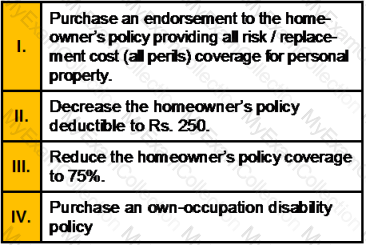
Section A (1 Mark)
In case of non-resident, who is carrying on shipping business, his Indian income shall be presumed to be:
Section B (2 Mark)
Markets would be inefficient if irrational investors __________ and actions of arbitragers were __________.
Section A (1 Mark)
In a bull spread, the investor makes profits if market goes
Section C (4 Mark)
Rhona has a daughter Zena five years old. She wants to plan for Zena’s education and has found out that she would be requiring 2,75,000 at her age 18 and another 4,50,000 on her age 25. She also wants to have Rs. 10,00,000 for Zena’s Marriage which she expects at the age of 28. She wants to deposit the entire amount for these expenses today in an account that pays a ROI of 15% per annum compounded annually. What would this amount be?
Section A (1 Mark)
______________ is based on a particular (theoretical) lottery game that leads to a random variable with infinite expected value, i.e., infinite expected payoff, but would nevertheless be considered to be worth only a very small amount of money.
Section A (1 Mark)
If the economy were going into a recession, an attractive industry to invest in would be the ________ industry.
Section A (1 Mark)
Which of the following is the fastest growing source of revenue for state and local governments in US?
Section B (2 Mark)
Under the Workmen Compensation Policy, when the employment injury results in death, the insurance company pays 40 % of the monthly wages of the deceased multiplied by the relevant factor or Rs. _________ whichever is more.
Section B (2 Mark)
Sunil insured the building of his house for a sum of Rs.500000 against fire insurance. One day the house is totally gutted in a devastating fire. The insurance surveyors certified that the building is a total loss with no salvage value and that the insurable value of the building just prior to the loss was Rs.1000000. The insurer will pay to Sunil:
Section A (1 Mark)
_______________ reveals that people often focus on short-term financial events to the detriment of their long-term needs.
Section A (1 Mark)
A(n)______________________ loan is a short- or medium-term loan repayable in two or more consecutive payments, usually monthly or quarterly.
Section A (1 Mark)
_______________ consists of the constatation that people buy both insurances and lottery tickets .
Section A (1 Mark)
The core of the_________________ is that even though stocks appear to be an attractive asset – they have high average returns and a low covariance with consumption growth – investors appear very unwilling to hold them.
Section A (1 Mark)
A bank is considering making a loan to Sumit Nayyar. Mr. Sumit has Rs 1,00,000 in the bank right now but generally keeps a balance of Rs 4,50,000 most of the year. What aspect of evaluating a consumer loan application is this fact concerned with?
Section A (1 Mark)
If the proposer does not disclose fully all the material facts at the time of Proposal the principle violated
Section B (2 Mark)
Mr. Subhash Bansal, a marketing manager is employed with IMFB limited. He took an advance of Rs. 1,20,000 against the salary of Rs. 30,000 per month in the month of March 2007. The gross salary of Mr Bansal for the assessment year 2007-08 shall be:
Section C (4 Mark)
As a CWM you are required to calculate the tax liability of an individual whose Taxable income is:
• $ 85650 in US dollars and he is a US citizen (single individual)
• $ 159000 in SGD and he is a citizen of Singapore
Section A (1 Mark)
____________ may be responsible for the prevalence of active versus passive investments management.
Section A (1 Mark)
Pure premium and Loss Ratio methods are two methods to determine
Section B (2 Mark)
Which of the following statements is/are correct with respect to Mental Accounting?
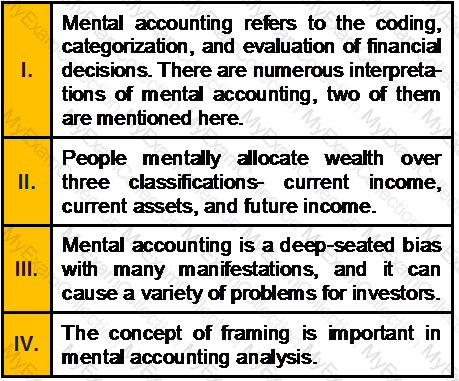
Section C (4 Mark)
Mr. Rajesh constructs a Long Straddle Strategy with one Nifty Call Option having a Strike price of Rs. 4500 available at a premium of Rs. 122 and one Nifty Put Option with a strike price Rs. 4500 at a premium of Rs. 85
What would be the Net Payoff of the Strategy?
• If Nifty closes at 4234
• If Nifty closes at 4766
Section C (4 Mark)
Mr. Chopra runs a Garment Factory, he is very concerned about his retirement and wants you to help him out in planning for it. His Current annual expenses are Rs. 12,00,000 which would be rising at an annual rate of 8% pre- retirement and 2% post retirement. His current age is 50 years and he wants to work till the age of 65. The expected life expectancy in his family is 75 years. Calculate the monthly contribution he must make till his retirement if the pre- retirement returns are 12% p.a. compounded monthly and post-retirement returns are 8% p.a compounded annually.
Section B (2 Mark)
As per Double Taxation Avoidance Agreement, the Royalties in Mauritius is charged at:
Section A (1 Mark)
An aggressive asset allocation would contain larger proportions of __________ than a conservative allocation.
Section A (1 Mark)
In which case, the probability of customer increases to become a defector?
Section C (4 Mark)
Read the senario and answer to the question.
Assuming his son gets average marks in class 10th when he was just 15 years old, his father decided to send him abroad for further studies at age 21.calculate the amount that Mr. Mehta requires to invest in excess of the amount accumulated in previous question during next six years to accumulate a fund of Rs. 500000?
Section B (2 Mark)
If one earns 10% on investment but inflation is 2%, real rate of return is
Section B (2 Mark)
NRIs are granted a special benefit by way of an option of being taxed at concessional tax rate of ________ as regards "investment income" and _______ as regards "long term capital gains" arising from "specified assets.
Section B (2 Mark)
Why do share prices usually drop when news about decline in a company’s earnings per share is reported?
Section B (2 Mark)
In 2011-12, an individual receives a net dividend of £648. The equivalent gross income is:
Section A (1 Mark)
A type of investor who is willing to risk his own capital and give up security to gain wealth is known as:
Section A (1 Mark)
A market timing approach that increases the proportion of funds in stocks when the stock market is expected to be rising, and increases cash when the stock market is expected to be falling is a:
Section C (4 Mark)
Read the senario and answer to the question.
Mahesh’s company has made plans for the next year. It is estimated that the company will employ total assets of Rs. 1000 lakh: 50% of the assets being financed by borrowed capital at an interest cost of 8% per year. The direct costs are estimated at Rs. 500 lakh. All other operating expenses are estimated at Rs. 76 lakh. The good will be sold to customer at 140% of the direct costs. Income tax rate is assumed to be 30%. Calculate net profit margin and return on owners’ equity.
Section B (2 Mark)
In order to determine the residential status of an NRI returning to India for permanent settlement, for the year of return, besides the stay not exceeding 181 days an additional condition is applicable that of stay not totalling to____________ days or more in relevant year if his stay in earlier ___________ years totaled to 365 days or more.
Section B (2 Mark)
Miss Femina aged 17, is married to Mr. Masculine. Her mother alone is alive income by way of interest on loans, of Miss Femina will be:-
Section B (2 Mark)
Assume that you purchased 100 shares of ABC in a self directed account and paid a commission on the transaction. Shortly following the purchase, you realize that you momentarily overlooked another 100 shares of ABC that you already owned in another account. Now, the redundant holdings are causing an imbalance in your overall portfolio.
What is your reaction to this situation, in case of Endowment Bias?
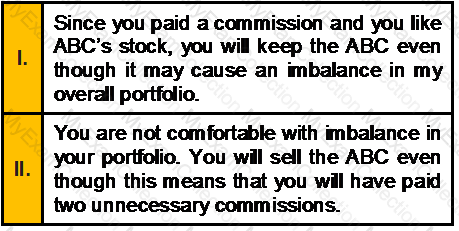
Section B (2 Mark)
Mr. Aggarwal is working in a reputed company and earning Rs. 4,50,000/- p.a. and is now 55 years old. He has invested Rs. 2,00,000/- in an annuity which will pay him after 5 years a certain amount p.a. at the beginning of every year for 10 years. Rate of interest is 8% p.a. Calculate how much he will receive at the beginning of every year after 5 years?
Section A (1 Mark)
_________________ is the most important source of revenue for states in US.
Section B (2 Mark)
A project should be considered if the Profitability Index is
Section A (1 Mark)
In case of self occupied property, higher deduction u/s24(b) for interest on loan for construction can be claimed if borrowing was made
Section A (1 Mark)
If a female dies without leaving any issue them property inherited from her father or mother the property will devolve upon
Section B (2 Mark)
As per article 12 Double Taxation Avoidance Agreement with Singapore, Royalties and fees for technical services arising in a Contracting State and paid to a resident of the other Contracting State may be taxed in that other State.However, such royalties and fees for technical services may also be taxed in the Contracting State in which they arise and according to the laws of that Contracting State, but if the recipient is the beneficial owner of the royalties or fees for technical services, the tax so charged shall not exceed__________ per cent.
Section B (2 Mark)
In 2011-12, Steven has business profits of £34,125, net bank interest of £1,240 and net dividends of £9,000. He claims the personal allowance of £7,475. What is the income tax payable for the year after subtracting tax deducted at source?
Section B (2 Mark)
What is the outstanding balance after 60 payments on a 20-year mortgage that has monthly payments of Rs1062.32 and an interest rate of 5.8% compounded semi-annually?
Section B (2 Mark)
Resident but not ordinary resident (RNOR) is ____________ on Indian Income and ___________ on Foreign Income.
Section B (2 Mark)
Any income chargeable under the based “Salaries†is exempt from tax under Section 10(6)(viii), if it is received by any non resident individual as remuneration for services rendered in connection with his employment in a foreign ship where his total stay in India does not exceed a period days in that previous year.
Section A (1 Mark)
These instruments rest on pools of credit derivatives that mainly insure against defaults on corporate bonds. The creators of these instruments do not have to buy and pool actual bonds but can create these instruments and generate revenues from selling and trading in them.
Section A (1 Mark)
Which of the following statements is/are correct with respect to naïve diversification?
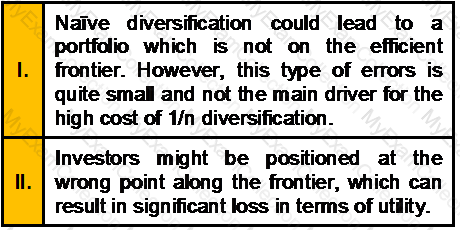
Section B (2 Mark)
Calculate Gross Annual Value where Gross Municipal Value is Rs.120, Fair Rent is Rs.105. Actual rent receivable is Rs.100& Standard Rent is Rs.125
Section C (4 Mark)
Read the senario and answer to the question.
Calculate the income from house property for Vinay. Municipal rental value 75000, Fair Rental value is 80000, Standard rent is 1,10,000. Municipal taxes paid for full house are Rs. 10,000 during the year. Interest paid by Vinay on borrowed money during the year is Rs. 101070.
Section C (4 Mark)
Suppose Gaurav, an investor, is looking to add to his portfolio and hears about a potential investment through a friend, Hitesh, at a local coffee shop. The conversation goes something like this:
GAURAV: Hi, Hitesh. My portfolio is really suffering right now. I could use a good long-term investment. Any ideas?
HITESH: Well, Gaurav, did you hear about the new IPO [initial public offering] pharmaceutical company called Pharma Growth (PG) that came out last week? PG is a hot new company that should be a great investment. Its president and CEO was a mover and shaker at an Internet company that did great during the tech boom, and she has Pharma Growth growing by leaps and bounds.
GAURAV: No, I didn’t hear about it. Tell me more.
HITESH: Well, the company markets a generic drug sold over the Internet for people with a stomach condition that millions of people have. PG offers online advice on digestion and stomach health, and several Wall Street firms have issued “buy†ratings on the stock.
GAURAV: Wow, sounds like a great investment!
HITESH: Well, I bought some. I think it could do great.
GAURAV: I’ll buy some, too.
Gaurav proceeds to pull out his cell phone, call his broker, and place an order for 100 shares of PG.
Which of the following biases have been exhibited by Gaurav?
Section C (4 Mark)
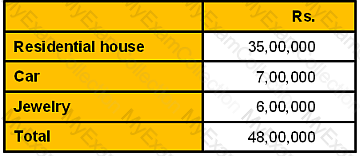
Mr. Jogen 57 years and 8 months old and going to retire after few months at the age of 58 years (after completing 33 years and 9months of service) is working as an assistant secretary in petroleum ministry. He is interested in making investments in Equity Market. Jogen purchased 100 shares of SBI Ltd. for Rs. 1,250/- per share at the beginning of the current financial year. It paid dividends of Rs. 20 per share over the year (February-08) and he sold the stock for Rs. 1,975 at the end of the year. His two children are well settled. He is staying in his own flat and has paid last installment of loan. He gets a salary of Rs. 48,000 p.m. After retirement he will get a pension of Rs. 16,000 p.m. His present (October -2007) household expenses per month are Rs. 22,000 and want to maintain same standard of living. His post-retirement expenses will be 95% of his last month’s expenses at retirement.
The present values of his physical assets are as below:
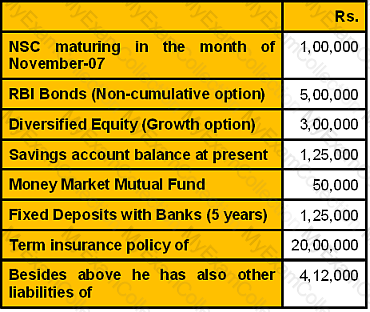
His financial assets are as follows:

He will get following amounts on his retirement:
Section C (4 Mark)
Read the senario and answer to the question.
During identification of new business opportunities, one of Harish’s friends Shekhar has offered him a business proposal. In this proposal a partnership firm consisting of two partners, Harish and Shekhar, shall take the franchise of a company which is a reputed brand in the field of pathology lab in which their investment and profit sharing ratio shall be equal.
Franchise rights shall be valid for 5 years and the project requires an upfront investment of Rs. 25 lakh for required infrastructure. The franchisee agreement has an option that the company can take over the franchisee after 5 years by charging depreciation @15% p.a. on straight line basis.
The projected profits from the firm are as follows:
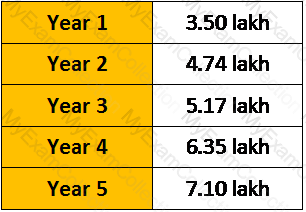
Harish wants to know what IRR he will earn on his investment from this project ? (Please ignore taxes and assuming no additional investment is made during this five year period)
Section B (2 Mark)
Regular collateralized debt obligations (CDO) have been surpassed by:
Section C (4 Mark)
Today is 14th February 2008 Mr. Mehta is 29 years old and is salaried. His wife, Nisha is a housewife. He has started depositing Rs. 5,000 at the beginning of each year in an education fund for his new born child.
He is earning a monthly income of Rs. 53000. His expenses are Rs. 27000 p.m. He takes the help of a wealth manager to plan his investments. He has taken housing loan and outstanding amount is Rs. 1000000 and outstanding amount on car loan is Rs. 300000.He is paying an EMI of Rs. 9547 on housing loan and an EMI of Rs. 2600 on car loan at the end of each year.
His other investments are as follows:
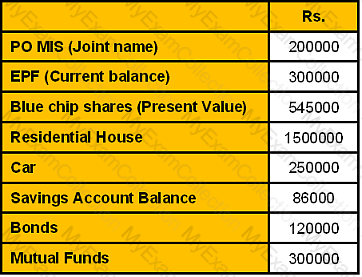
Mr. Mehta has joined the services after completing his education five years back. But during the previous year he works for 230 days.
Assumptions

Section B (2 Mark)
A bank is about to make a Rs50 million project loan to develop a new oil field and is worried that the petroleum engineer's estimates of the yield on the field are incorrect. The bank wants to protect itself in case the developer cannot repay the loan. Which type of credit derivative contract would you most recommend for this situation?
Section C (4 Mark)
Read the senario and answer to the question.
If Mahesh has the option of 3 funds whose details are as below, find Jensen’s index for fund A, Treynor index for fund B and Sharpe index for the market
Section C (4 Mark)
OMG Petro Ltd produces and markets crude oil. The following are selected numbers from the financial statements for 1992 and 1993 (in millions).
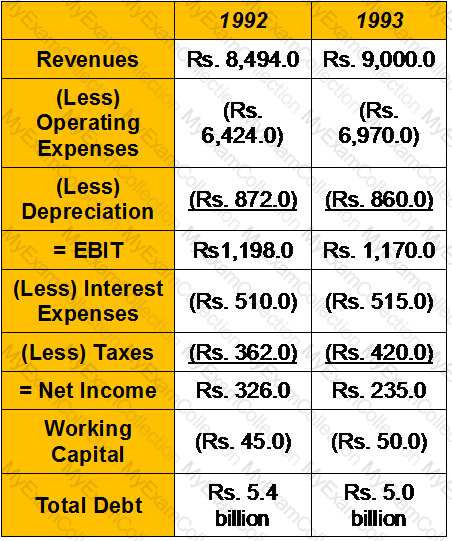
The firm had capital expenditures of Rs950 million in 1992 and Rs1 billion in 1993. The working capital in 1991 was Rs190 million, and the total debt outstanding in 1991 was Rs5.75 billion. There were 305 million shares outstanding, trading at Rs21 per share.
Estimate the cash flows to equity in 1992 and 1993(in Rs Millions)
Section B (2 Mark)
If Second National Bank has more rate-sensitive liabilities then rate-sensitive assets, it can reduce interest rate risk with a swap that requires Second National to
Section A (1 Mark)
Which of the following is a challenge of making a consumer loan?
Section A (1 Mark)
Income accruing in Sri Lanka and received there is taxable in India in case of
Section B (2 Mark)
Jaipur Golden Railroad reported net income of Rs770 million in 1993, after interest expenses of Rs. 320 million. (The corporate tax rate was 36%.) It reported depreciation of Rs.960 million in that year, and capital spending was Rs1.2 billion. The firm also had Rs. 4 billion in debt outstanding on the books, rated AA (carrying a yield to maturity of 8%), trading at par (up from Rs3.8 billion at the end of 1992). The beta of the stock is 1.05, and there were 200 million shares outstanding (trading at Rs 60 per share), with a book value of Rs5 billion. Jaipur Golden paid 40% of its earnings as dividends and working capital requirements are negligible. (The treasury Bill rate is 7%.)
Estimate the free cash flow to the firm in 1993.
Section A (1 Mark)
Surender is a driver who causes injuries to a pedestrian by his rash driving. The injured victim had to spend Rs.1000 in treating his injuries. Surender ‘s act has created liabilities under:
Section B (2 Mark)
Total income for assessment year 2012-13 of an individual including long-term capital gain of Rs. 60,000/- is Rs. 1,80,000/-. The tax on total income shall be: [CII-12-13: 852,11-12: 785,10-11:711]
Section C (4 Mark)
Suppose Nifty is at 4500 in May. An investor, Mr. A, executes a Short Strangle by selling a Rs. 4300 Nifty Put for a premium of Rs. 23 and a Rs. 4700 Nifty Call for Rs 43.
What would be the Net Payoff of the Strategy?
• If Nifty closes at 3735
• If Nifty closes at 5265
Section A (1 Mark)
Which of the following is not one of the five core process according to Payne’s five-process model ?
Section A (1 Mark)
Loans to individuals and families to finance the purchase of new homes are known as:
Section B (2 Mark)
The basic rate of income tax on non-savings incomein UK for tax year in 2011-12 is:
Section A (1 Mark)
To ensure compliance under this method of lending, the current ratio of the concern should not be less that _________
Section A (1 Mark)
The price that the buyer of a put option pays to acquire the option is called the
Section A (1 Mark)
The minimum income criteria for Personal Loans in case of Salaried employees is:
Section B (2 Mark)
Which of the following statements concerning index funds and actively managed funds is true?
Section A (1 Mark)
Single men trade far more often than women. This is due to greater ________ among men.
Section C (4 Mark)
Assume the following;
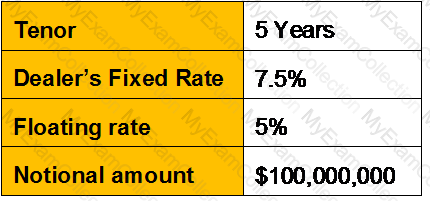
With this agreement, every 6 months, the transfer of funds takes place between fixed rate payer and floating rate payer.
What would Net Cash flows after 6-months from the initiation date?
Section B (2 Mark)
As Per Article 11 Double Taxation Avoidance Agreement with UK, a dividend paid by a company which is a resident of the United Kingdom to a resident of India may be taxed in India. Where under paragraph 2 of this Article, a resident of India is entitled to a tax credit in respect of that dividend, tax may also, be charged in the United Kingdom and according to the laws of the United Kingdom on the aggregate of the amount or value of the dividend and the amount of the tax credit, at a rate not exceeding ___________ percent.
Section B (2 Mark)
Accrued Interest on loan for self occupied property is Rs.110000 till 31 March 2010. Loan was taken for construction on 31/07/2006 and construction completed on 03/04/10. Interest for the year 2010-11 is Rs 22000. Determine what interest shall be allowed u/s 24(b) for AY 2011-12.
Section B (2 Mark)
An approved superannuation fund must have a minimum of _______ trustees
Section B (2 Mark)
In US, all states except _________________ require their state, via state constitutional or statutory requirements, to balance their budget.
Section C (4 Mark)
Consider the following information for three mutual funds
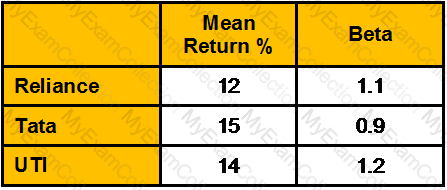
Risk free return is 7%. Calculate Treynor measure?
Section B (2 Mark)
The income of any university or other educational institution existing solely for educational purposes and not for the purposes of profit is exempt under clause (iiiad) of Section 10(23C) if the aggregate annual receipts’ of such univerÂsity or educational institution do not exceed.
Section A (1 Mark)
To try to develop a property’s competitive edge, an investor should consider which of the following?
Section B (2 Mark)
Ajay is considering to purchase a house which will bring rental income of Rs. 15,000/- p.m at the end of month. Ajay is looking for 12% returns and he is expecting to sell the property after 5 years for Rs. 6 lac. What price Ajay should pay for this property now?
Section B (2 Mark)
Ram is working in Rashid Enterprises, a proprietorship firm.During his working hours Ram was injured seriously. Due to this injury Ram was hospitalized for six months. Ram is the only bread winner of his family. Ms. Rashid, the proprietor of Rashid Enterprises is liable to pay damages to Ram. Under which of the following policy Rashid can protect himself from this liability?
Section C (4 Mark)
Navin Corporation, a manufacturer of do-it-yourself hardware and housewares, reported earnings per share of Rs2.10 in 1993, on which it paid dividends per share of Rs0.69. Earnings are expected to grow 15% a year from 1994 to 1998, during which period the dividend payout ratio is expected to remain unchanged. After 1998, the earnings growth rate is expected to drop to a stable 6%, and the payout ratio is expected to increase to 65% of earnings. The firm has a beta of 1.40 currently, and it is expected to have a beta of 1.10 after 1998. The Risk Free rate is 6.25%.
What is the value of the stock, using the two-stage dividend discount model?
Section B (2 Mark)
Which of the following is/are the Potential Challenges for wealth management players in India?
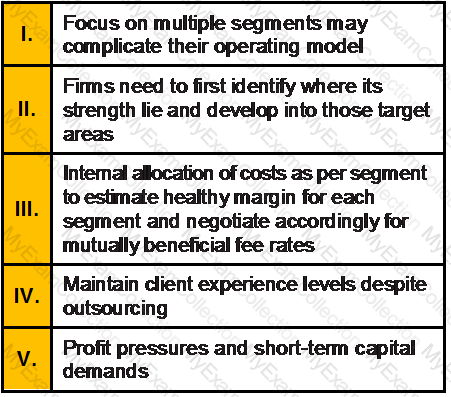
Section B (2 Mark)
As per Double Taxation Avoidance Agreement, the Technical Fees in UAE is charged at:
Section C (4 Mark)
The expected return for the market is 12 percent, with a standard deviation of 20 percent. The expected risk-free rate is 8 percent. Information is available for three mutual funds, all assumed to be efficient, as follows:
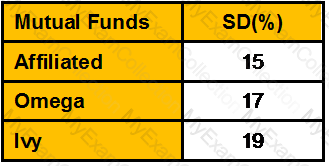
Calculate the expected return on each of these portfolios respectively.
Section C (4 Mark)
United Healthcare, a health maintenance organization, is expected to have high earning growth for the next five years and 6% after that. The dividend payout ratio will be only 10% during the high growth phase, but will increase to 60% in steady state. The return on equity was 21% in the most recent time period and is expected to stay at that level for the next 5 years. The stock has a beta of 1.65 currently, but the beta is expected to drop to 1.10 in steady state. (The treasury bill rate is 7.25%.)
Estimate the price/book value ratio for United Healthcare, given the inputs above.
Section C (4 Mark)
Rate of 15% p.a compounded annually will be equal to ---------------- % per month.
Section B (2 Mark)
If a stock GHI ltd pays an annual dividend of Rs. 5 and plans to follow this policy for ever, then what would be the ate of return that investor would realize given the current market price of stock is 100?
